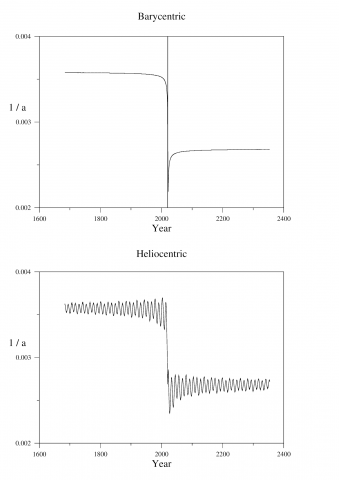- This topic has 8 replies, 5 voices, and was last updated 5 years, 4 months ago by
 Dr Paul Leyland.
Dr Paul Leyland.
-
AuthorPosts
-
30 July 2020 at 10:26 am #574687
 Ray EmeryParticipant
Ray EmeryParticipantWe have had much discussion within the Leeds AS Zoom sessions about The Comet. It is frequently stated on the ‘Net that the orbital period on this passage has increased from c. 4200 years to c. 6800 years, but without any explanation. Is this the case? If so, what is the cause? Seems an awfully large increase for it to be due to outgassing / solar wind pressure alone, yet no close passes by planetary bodies appears to be involved. Enlightenment would be welcome. Thanks!
30 July 2020 at 7:54 pm #582947 Nick JamesParticipant
Nick JamesParticipantRay,
The change is mainly due to the gravitational perturbations of the major planets. The orbital period is very sensitive to the eccentricity so a small change in e has a big effect on the period since a = q / (1 – e) and P = a^(3/2). The attached plots show the results you get if you integrate the current orbit forwards and backwards including the gravitational effects of all the planets and the biggest asteroids. There is a clear 12 year signature which is Jupiter but you can also see the large change in period corresponding to the small change in eccentricity.


 30 July 2020 at 8:04 pm #582948
30 July 2020 at 8:04 pm #582948 Ray EmeryParticipant
Ray EmeryParticipantNick – fair enough! I will have to bow to the cognoscenti (as usual). Many thanks.
30 July 2020 at 8:05 pm #582949James Lancashire
ParticipantAccording to BAA comet info (JDS) the comet was discovered on 2020 Mar 27 so we have just 4 months of observations out of 4200 or 6800 years.
I suspect the ‘increase’ in orbital period is simply due to a longer arc of observations which has revised the orbital elements rather than genuine non-gravitational effects around perihelion.
According to in-the-sky the inclination is 129deg so the comet will hardly encounter planets for perturbations. And with semi-major axis at 364AU it will very quickly be well away from the plane of the solar system, plus very hard to detect!
Playing with in-they-sky’s orbit diagram, perihelion was ‘superior’ (and for all ‘inner’ planets). The comet passes through descending node outside Mars approx Oct 2020 which is well away from all the planets’ positions. So it’s a gravitational orbit till next perihelion!
31 July 2020 at 11:28 am #582951 Ray EmeryParticipant
Ray EmeryParticipantWell, I had tried the interactive comet orbit model myself, which is what made me think that the planets would not have had much of a gravitational effect. But I bow to those on a higher plane (pardon the pun) than myself. Cat amongst the pigeons – good stuff.
1 August 2020 at 2:57 pm #582960 Dominic FordKeymaster
Dominic FordKeymasterI think the point here is that this is a very long-period comet, so its speed is very close to solar system escape velocity right now. Even a tiny bit of extra energy from Jupiter can push its aphelion out a long way and significantly increase its period.
This is what Nick meant when he said that a small change in eccentricity has a big effect on period. When e is very close to 1 (i.e. a long-period comet), a very small change in e has a very big effect on the (1-e) term in Nick’s equation!
2 August 2020 at 12:19 pm #582965 Dr Paul LeylandParticipant
Dr Paul LeylandParticipantIndeed. A comet in an orbit with eccentricity of 0.99999 has a large but finite period. One with an eccentricity of 1.00001 has infinite period in that (pending a gravitational interaction with some other body) it will never return to the inner solar system.
5 August 2020 at 7:03 am #582968 Nick JamesParticipant
Nick JamesParticipantI had an email from Graeme Waddington pointing out that the periodic wiggles due to Jupiter and the other planets disappear if you use a barycentric coordinate system rather than heliocentric. This is because, when the comet is far out, it is orbiting around the centre of mass of the Solar System (the barycentre) which is not exactly at the centre of the Sun. Graeme’s plots are attached. The y axis is 1/a which, if you remember from my first post, is equal to (1-e)/q so it has the big advantage that it is well conditioned for orbits where e is near to 1 (i.e. it doesn’t tend to infinity as e tends to 1). Graeme notes “At the ends of the time frame plotted the comet is at 244 au and 250 au from the sun –> P(orig.) = 4674 yr, P(future) = 7200 yr. For a similar integration using the JPL15 orbit I get 4434 and 6718 years respectively.”
 5 August 2020 at 11:04 am #582969
5 August 2020 at 11:04 am #582969 Dr Paul LeylandParticipant
Dr Paul LeylandParticipantIt is many years since I last had contact with Graeme. We used to see each other moderately often when we both worked at Oxford University.
Any chance that you could pass on my contact details to him please?
-
AuthorPosts
- You must be logged in to reply to this topic.
